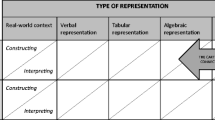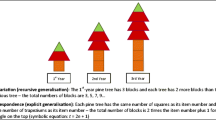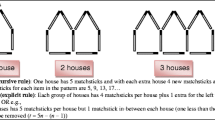Abstract
This study analyses some of the consequences of adopting a functional/modelling approach to the teaching of algebra. The teaching of one class of 17 students was observed over five weeks, with 15 students undertaking both pre- and post-tests and 6 students and the teacher being interviewed individually. Use of graphics calculators made the predominantly graphical approach feasible. Students made considerable progress in describing linear relationships algebraically. They commented favourably on several aspects of learning concepts through problems in real contexts and were able to set up equations to solve contextualised problems. Three features of the program exerted a ‘triple influence’ on students’ use and understanding of algebraic symbols. Students’ concern to express features of the context was evident in some responses, as was the influence of particular contexts selected. Use of graphics calculators affected some students’ choice of letters. The functional approach was evident in the meanings ascribed to letters and rules. Students were very positively disposed to the calculators, and interesting differences were observed between the confidence with which they asked questions about the technology and the diffidence with which they asked mathematical questions.
Similar content being viewed by others
References
Asp, G., Dowsey, J., Stacey, K. & Tynan, D. (1995). Graphic algebra: Explorations with a function grapher. Carlton, VIC: Curriculum Corporation.
Asp, G., Dowsey, J., Stacey, K. & Tynan, D. (1998). Graphic algebra: Explorations with a graphing calculator. Berkeley, CA: Key Curriculum Press.
Bednarz, N., Kieran, C. & Lee, L. (Eds.) (1996). Approaches to algebra: Perspectives for research and teaching. Dordrecht, Netherlands: Kluwer Academic Publishers.
Clement, J., Lochhead, J. & Monk, G. (1981). Translation difficulties in learning mathematics. American Mathematical Monthly, 88, 289–290.
Freudenthal, H. (1991). Mathematics as a new educational task. Dordrecht, Netherlands: Kluwer Academic Publishers.
Gravemeijer, K. (1999). How emergent models may foster the constitution of formal mathematics. Mathematical Thinking and Learning, 1(2), 155–177.
Heid, M.K. (1996). A technology-intensive functional approach to the emergence of algebraic thinking. In N. Bednarz, C. Kieran & L. Lee (Eds.), Approaches to algebra: Perspectives for research and teaching (pp. 239–255). Dordrecht, Netherlands: Kluwer Academic Publishers.
Janvier, C. (1996). Modeling and the initiation into algebra. In N. Bednarz, C. Kieran & L. Lee (Eds.), Approaches to algebra: Perspectives for research and teaching (pp. 222–238). Dordrecht, Netherlands: Kluwer Academic Publishers.
Kieran, C., Boileau, A. & Garançon, M. (1996). Introducing algebra by means of a technology-supported, functional approach. In N. Bednarz, C. Kieran & L. Lee (Eds.), Approaches to algebra: Perspectives for research and teaching (pp. 257–293). Dordrecht, Netherlands: Kluwer Academic Publishers.
Kissane, B. (1999). The graphics calculator as an investigative tool. Paper presented at the Australian Association of Mathematics Teachers Virtual Conference 1999 CD_ROM.
Kissane, B. (2001). Technology and the curriculum; the case of the graphics calculator. In M.O.J. Thomas (Ed.), Proceedings of TIME 2000: An international conference on technology in mathematics education (pp. 60–71). Auckland, New Zealand.
Kuchemann, D.E. (1981). Algebra. In K.M. (Ed.), Children’s understanding of mathematics, 11–16 (pp. 102–119). London: John Murray.
MacGregor, M. & Stacey, K. (1993). Seeing a pattern and writing a rule. In I. Hirabayashi, N. Nohda, K. Shigematsu & F.-L. Lin (Eds.), Proceedings of seventeenth international conference for the psychology of mathematics education (Vol. I, pp. 181–188). University of Tsukuba, Japan, July.
MacGregor, M. & Stacey, K. (1997). Students’ understanding of algebraic notation: 11–16. Educational Studies in Mathematics, 33(1), 1–19.
Author information
Authors and Affiliations
Additional information
Kaye Stacey: Author for correspondence.
Rights and permissions
About this article
Cite this article
Bardini, C., Pierce, R.U. & Stacey, K. Teaching Linear Functions in Context with Graphics Calculators: Students’ Responses and the Impact of the Approach on Their Use of Algebraic Symbols. Int J Sci Math Educ 2, 353–376 (2004). https://doi.org/10.1007/s10763-004-8075-3
Issue Date:
DOI: https://doi.org/10.1007/s10763-004-8075-3




